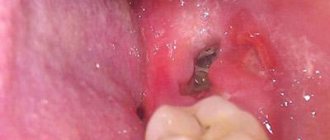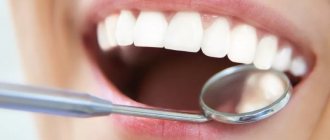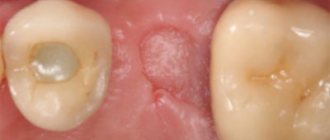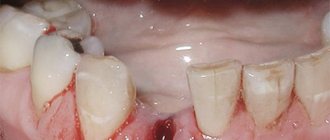Tooth extraction is one of the most popular and simplest operations in medicine. Usually it passes without complications, but due to a number of general or subjective reasons, deviations may occur. One such postoperative complication is dry socket.
The fact is that after extraction of a tooth, a cavity forms in its place, which, in a positive scenario, is filled with a blood clot. It prevents the penetration of microbes into an open wound and promotes its speedy healing. A dry socket after tooth extraction is the absence of that same blood clot in the socket. This can happen for two reasons:
- Loss or resorption.
- Severe bleeding that prevented a clot from forming.
Whatever the reason, the healing process can take weeks and be accompanied by serious discomfort, which is not always possible to eliminate on your own.
Symptoms
Dry socket syndrome is very painful. It is quite easy to identify if the following symptoms appear within 2-3 days after tooth extraction:
- inflammation of the gums, accompanied by severe pain;
- pain in the cervical region and ears;
- the appearance of bad breath;
- taste of pus in the mouth;
- partial hearing loss;
- general malaise
Visually, a dry socket is an empty depression at the site of tooth growth, first exposing the jawbone, and then turning into a reddened, purulent wound.
Normally, the socket is a cavity that, after tooth extraction, is filled with ichor. Over the next three days, the clot thickens, and light fibrin stripes appear on it - the beginning of the formation of new gum tissue. There may be slight soreness at the wound site. From 4 to 7 days, swelling gradually subsides, and the gums acquire their usual pink color. There is no pain.
How long does the healing process take?
If the tooth is removed efficiently, then normally the healing speed does not exceed more than 2.5 weeks. The speed of regeneration depends on the location of removal. In case of amputation of a single-rooted tooth, the wound should heal within 2 months. In case of wisdom tooth removal - a little later, after 2.5–3 months. During this time the following happens:
- tissue restoration and regeneration:
- formation of the bone shell.
If the extracted tooth leads to rupture or injury to the surrounding tissues, the formation of a hole with torn or far apart edges, then the process will take longer - up to 1.5 months, until young bone tissue grows and the gum cover is completely formed.
Why is the process taking so long?
The hole takes a long time to heal and heal after tooth extraction, sometimes due to the fault of the dentist when carrying out incorrect manipulations, failure to comply with sanitation conditions, leaving food particles or bone fragments that can lead to the development of an inflammatory process and suppuration. When the gums heal slowly after tooth extraction, the patients themselves are usually to blame and the reasons for this are:
- frequent rinsing of the mouth, washing out blood clots from the wound, when there is a high probability of re-infection when germs and bacteria penetrate into the hole;
- excessive trauma to the socket due to eating solid food or brushing teeth with non-sterile hard toothbrushes;
- taking medications to thin the blood;
- diseases - diabetes mellitus and poor clotting.
It is the formation of blood clots in the formed hole that is protection and cover from the entry of microbes, stimulation for the restoration and regeneration of damaged tissues. The entry of foreign particles into an injured socket can lead to inflammation, delayed healing and suppuration, and the development of pulpitis, gingivitis, and stomatitis.
If the bleeding does not go away after 2-3 days, the gums do not heal for a long time, and there is a putrid smell from the mouth, then it is better to visit the dental office again and consult with a specialist.
Causes of dry socket
There are several causes of dry socket. Some of them can be prevented by following simple recommendations regarding personal hygiene and caution. Causes:
- smoking. In this case, there is a decrease in pressure in the oral cavity, which can lead to the loss of the formed clot;
- neglect of oral hygiene;
- low blood clotting;
- taking oral contraceptives;
- mechanical damage to the hole itself or the tissues around it.
In addition to the above reasons, a dry socket can appear as a result of an incorrectly performed tooth extraction procedure. During a complex extraction, when the tooth had to be removed from the gums in parts. All rules recommended before and after extraction must be followed.
Ways to speed up healing
The best thing a patient can do to speed up epithelialization is to create conditions in the oral cavity that are close to sterile. To do this, you must follow some rules:
- Squeeze the cotton swab applied after surgery tightly with your teeth for 15-20 minutes.
- Do not eat for 3 hours so as not to interfere with the clot formation process.
- In the first days, do not smoke, give up alcohol and solid food.
- Avoid heavy physical activity, temperature effects (hot drinks and dishes, trips to the bathhouse, sauna).
- Do not chew on the injured side for two days.
- Avoid rinsing and use chlorhexidine baths instead.
- Take prescribed medications - for example, antibiotics, which are prescribed after a complex removal, in the presence of purulent processes.
- After consulting with your doctor, use Solcoseryl, a gel that helps accelerate epithelization.
It is important to remember that the area where the deletion took place is a very vulnerable place. The mouth is home to a large number of opportunistic microorganisms, which, in the presence of a source of bleeding, become pathogenic, triggering the inflammatory process. To perform the operation, you should choose an experienced surgeon and strictly follow his recommendations after the procedure.
Consequences
If during the first two days after tooth extraction pain appears, swelling does not subside and the temperature rises, then most likely these are signs of inflammation. In this case, you should immediately consult a doctor, as dry socket syndrome can lead to serious complications. Such as:
- flux.
It begins to form when an infection gets into the hole. Characterized by severe swelling and pain. Requires immediate specialist intervention. - alveolitis
This is a deeper penetration of the infection - deep into the gums. Bacteria spread quickly and, if this process is not stopped in time, there is a risk of tissue necrosis. In this case, the losses can be very serious.
Attention!
The consequences of untimely or incorrect treatment can be irreversible. Do not neglect your doctor's advice. A wound on the mucous membrane is always a vulnerable area, subject to attack by bacteria and their rapid spread.
How much does tooth extraction hurt the gums?
Assessing how severe the harm from tooth extraction will be is not always easy. Sometimes removal can take much longer and have a very negative impact on the condition of a person’s gums. And here it doesn’t really matter which doctor performs the procedure - there are many potential complications.
Among the most notable factors of injury are the following:
- Rupture of the ligaments and muscles that hold the tooth. They help the tooth stay inside the socket and not become loose over time.
- Tissue damage. We are talking about both periodontal and periodontal tissues. They can heal for quite a long time.
- Impact on the vascular system and nerves. Serious damage to blood vessels and nerves can usually occur. It is precisely because of the likely contact of blood with pathogenic bacteria during the recovery period that it is important to observe hygiene standards.
When going through the recovery process, you should be prepared for the fact that signs characteristic of inflammation will be observed for some time. In this case, swelling may appear, the temperature of the tissue at the site of removal may increase, and bleeding may occur. Pain also becomes a frequent companion during the recovery period.
In our clinic, removal is performed as carefully and carefully as possible. The extensive experience of doctors allows us to minimize tissue damage and reduce trauma. We will also answer the question of how long it takes for gums to heal and how to properly care for the socket so that it heals as quickly as possible.
Forms of alveolitis
Depending on the course of the complication, three stages are distinguished:
- Serous.
It makes itself felt
2-3 days
after tooth extraction. At this stage, pain occurs when eating, headache. Lymph nodes increase in size. - Purulent.
This is the next form that occurs after the serous one, if timely treatment is not carried out. Diagnosed a week after the tooth was removed. The pain becomes unbearable and is also felt in the head or ear. The hole becomes covered with a purulent, dirty yellow coating. There is an unpleasant odor from the mouth. Swelling and lymph nodes enlarge and become painful. Opening your mouth and eating food is extremely difficult due to pain. - Hypertrophic.
At this stage, it seems that the symptoms are subside: the condition is normalized, the temperature decreases. However, atrophied tissue grows, and when pressure is applied, pus is released from the inflamed wound.
If you notice any of the above symptoms, you should not self-medicate, but rather consult a dentist.
Symptoms of alveolitis
As a rule, the patient ignores the first symptoms of inflammation without due attention, considering them to be the norm after surgery. After tooth extraction, as already noted, pain within 24 hours is considered normal. As the hole heals, the pain subsides and completely disappears after a few days.
If the patient develops an inflammatory process, then the unpleasant sensations do not subside after a day or two, and 3–5 days after the operation, severe, throbbing pain in the socket occurs, which intensifies as the infection develops.
With alveolitis, patients may complain of both unbearable and moderate pain. Pulsation and pain are focused, as a rule, only in the removal area. However, in rare cases, the pain radiates to half of the face.
Other characteristic symptoms of alveolitis are:
- a sharp rise in body temperature;
- tooth sensitivity to hot/cold food;
- enlargement of the submandibular lymph nodes;
- decreased appetite;
- increased salivation.
In rare cases, the disease causes weakness, increased fatigue, and secondary infectious foci appear on the oral mucosa.
Diagnosis and treatment methods
Diagnostics at a dentist's appointment will help confirm the symptoms of a dry socket. After an examination, the doctor will prescribe treatment. As a rule, it depends on the stage of inflammation. In the case of a mild form, drug treatment with antiseptics and anti-inflammatory drugs is possible. At the middle stage, you will need antibacterial therapy, as well as cleaning the hole from pus and filling it with an anti-inflammatory drug. All actions are performed under anesthesia. If necessary, antibiotics are prescribed.
At the third stage, the most advanced stage, the patient may need hospitalization and even surgical intervention. With proper care and no complications, the hole heals within seven days. And a month later there is no trace left of her.
How long does it take for gums to heal after tooth extraction?
Tooth extraction can be emergency or planned, but in each case healing occurs the same way.
Extraction of the organ is carried out when it is not possible to preserve the crown, in case of severe inflammation, or in advanced periodontal disease. The operation is performed under anesthesia, so there is no pain during removal. Unpleasant symptoms appear after the end of the dentist’s visit. The gums in the area of the removed organ hurt, but normally this goes away after seven days.
When the gums still hurt seven days after the tooth extraction is completed, and the inflammation does not subside for a long time, this indicates a complication. The most common consequences of organ extraction are alveolitis, bleeding, fracture, and injury to the socket.
Features of wisdom tooth removal
Dry socket after wisdom tooth removal is not uncommon. This syndrome occurs especially often in the lower jaw due to the fact that as a result of swallowing and opening the mouth, the muscles tense, aggravating the appearance of a dry socket and, as a result, alveolitis. Dry socket occurs in approximately 50% of cases
. Due to the anatomical features of the jaw, the blood clot often falls out.
When extracting a wisdom tooth, you must carefully observe precautions and resort to this procedure only in cases of extreme necessity. After all, the inaccessibility of the place complicates treatment.
Why does the hole take a long time to heal?
Epithelization of the gums after the operation begins after a couple of days, and a white coating appears on it. Now it doesn’t hurt so much anymore, and there are no signs of inflammation. At this time, it is better not to touch the mucous membrane, but just continue to properly take care of the hole. It may not heal for a long time due to the patient’s personal quirks, at a time when there are diseases of the circulatory system or chronic inflammatory processes in the body.
If your gums hurt very badly after seven days, this is possible:
- Dry socket or alveolitis - this complication often appears when the rules for organ removal are not followed, while part of the crown or root remains in the socket. Under such conditions, the blood clot, which should protect against infection, falls out. This complication much more often begins on the 5th day after the end of the operation. Common symptoms are gum discoloration, unpleasant odor, halitosis, soreness, slight bleeding;
- Chronic bleeding - this complication is observed in people with hypertension and in the case of blood diseases. This may result in alveolitis. Before sending the patient home, the dentist stops the bleeding and places a hemostatic sponge on the hole;
- A fracture or dislocation of the lower jaw is a rare complication that occurs more often during the removal of a wisdom tooth; the risk increases if there is a cystic formation or acute inflammatory process in the root area;
- Perforation of the maxillary sinus is possible as a result of complex removal of chewing teeth in the upper jaw.
If the hole hurts for a long time, and it does not go away after seven days, you should immediately consult a doctor. It is forbidden to cope with complications that appeared during the removal on your own. Apart from this, there is no way to prevent them, so first aid is provided immediately after the procedure is completed.
Complications due to improper care, which slow down gum healing, can be prevented on your own.
Treatment of dry tooth socket at home
If the pain from dry socket inflammation is too severe, you can take painkillers. In the first two days, apply cold compresses to the inflamed side at intervals of 20 minutes, then change to warm ones.
Drink more fluids, especially water. It removes harmful substances from the body. Avoid alcohol.
Rinse your mouth with a salt water solution. This clears the wound of dead cells and relieves inflammation. But you should not apply pressure in the area of the hole - you can provoke the displacement of the blood clot. You should rinse your mouth after every meal and before going to bed.
You can also apply a drop of clove oil to the wound to relieve pain. Rinsing with sage and chamomile flowers, a decoction of burdock leaves and aspen bark, and anise infusion will also have a positive effect.
If after all the treatments the pain has not subsided, the swelling has not subsided, and your health has only worsened, then you should urgently consult a doctor. There is a high probability that the process of rotting has begun.
In the dental office, the doctor, under anesthesia, will clean the hole or prepare the gums - depending on the degree of neglect of the case. Fill it with antiseptic gel.
Treatment of alveolitis
When the socket becomes inflamed, the main thing is to eliminate the source of infection, prevent the development of inflammation and preserve the dentition. In order to alleviate the patient’s condition, the dentist uses the following therapy methods:
- Mechanical cleansing of the hole, washing out purulent residues with a solution of nitrofural or hydrogen peroxide.
- Anesthesia of the hole. The pain syndrome is relieved with the help of local applications with anesthetics and analgesics. To do this, the doctor applies the lotion for half an hour and then removes it to prevent the proliferation of microbes in the area. The dentist will advise the patient to repeat the procedure several times a day. Taking painkillers orally is not recommended.
- Taking antibiotics. In the presence of concomitant diseases, alveolitis is treated with antibiotics.
With the right approach, the signs of alveolitis subside 2-3 days after the start of treatment. If therapy was not started on time, residual pain may drag on for 2–3 weeks.
With the permission of the dentist, additional treatment of alveolitis with folk remedies is possible:
- Sage rinses. To prepare the solution, brew a large spoonful of dry sage in 250 ml of boiling water, leave the mixture for an hour, wrapping the container in a towel. After this, the liquid should be filtered and used for rinsing.
- Gargling with chamomile flowers. To prepare the composition, brew a large spoonful of chamomile flowers in a glass of water for 15 minutes, insulating the container with a towel. The infusion should be strained and rinsed your mouth up to 12 times a day.
- Poplar buds. To prepare, take half a glass of buds, pour into a glass container and pour in 500 ml of vodka. The product should be infused for 10 days in the dark and cool, then filtered, soaked in cotton swabs and applied to the inflamed area.
- A soda rinse solution can also be an effective addition in the treatment of alveolitis. You should take a large spoonful of powder in a glass of warm water or mix soda with water to obtain a paste-like mass, which then needs to be used to treat the hole.
- Burdock leaves. To prepare a medicinal decoction of burdock leaves, you need to pour 20 grams of raw material with 2 glasses of water, and then simmer the mixture over low heat for about 40 minutes. The resulting solution should be cooled and filtered, and then used for rinsing.
- Aspen bark. Pour 1 tablespoon of crushed aspen bark into one glass of boiling water. It is important to leave the solution in an airtight container for 3 hours, and then use 100 ml of strained warm liquid at least 3 times a day.
- Anise infusion. To prepare the infusion, pour 1 tablespoon of anise into 200 ml of boiling water, and then keep in a thermos for 50 minutes. The liquid should be filtered and used to rinse 3 times a day.
Prevention
Preventing dry socket is always easier and cheaper than treating dry socket. To do this, you need to follow a number of preventive measures. Namely:
- If possible, limit physical activity for several days after tooth extraction;
- do not touch the removal site with your hands or tongue;
- do not chew on this side;
- eliminate the use of tobacco and alcohol;
- do not eat too hot, cold or spicy foods;
- It is advisable to grind food into puree.
Expert of the article Bolshakova Evgenia Vladimirovna Dentist-hygienist
More than 11 years of experience
How to properly care for your gums
To prevent complications from occurring, you should follow a few simple recommendations:
- Do not heat the gum. Strong heat can stimulate the spread of the inflammatory process.
- Use a soft brush. At the same time, when brushing your teeth, try not to touch the gums at the extraction site.
- Use additional cleaning products. These include irrigators and dental floss.
- Try to use toothpastes with soothing herbal ingredients.
It is very important not to self-medicate. If any problem arises, you should consult a doctor as soon as possible.
Treatment in the clinic
The optimal solution for treating a diagnosis of dry socket or alveolitis is a visit to the dentist. It is better to go to the same doctor who performed the tooth extraction, since he already knows the course of the operation, did the diagnostics and remembers the characteristics of your body.
Whatever clinic you choose to contact, study its website, the doctors who work there and reviews.
At the RUTT dental center we use the latest equipment and advanced materials. The experience of our doctors is confirmed by numerous diplomas, certificates and awards. You can be sure that you will be in the hands of a reliable specialist.
Why does alveolitis begin?
A slight inflammation in the socket is an inevitable process, since during tooth extraction tissue is injured and an open wound appears, and the environment in the mouth is unsterile. But alveolitis does not occur in everyone. So why does an infection get into the hole that the human body cannot cope with on its own?
Causes of infectious inflammation in the socket
The natural protective barrier is destroyed
A blood clot forms at the site of the extracted tooth; it closes the wound and protects it from infection. If this natural barrier is destroyed, for example by rinsing the mouth after tooth extraction, then the infection can penetrate into the tissue of the hole and provoke inflammation.
Poor oral hygiene
Bacteria live in the oral cavity. During the doctor’s manipulations, as well as after them, particles of tartar or soft plaque can get into the wound. This is a very good environment for bacteria, so they multiply quickly. Severe inflammation begins.
Poor sterilization of surgical instruments
Paradoxically, an infection in the socket can also be caused by a dental surgeon who uses poorly sterilized instruments.
Violation of the rules for processing the tooth socket
After surgery, especially if the extracted tooth had a granuloma, the doctor must carefully treat the wound so that it fills with blood to form a clot, and apply sterile cotton wool. Neglecting these rules can provoke alveolitis.
Violation of doctor's recommendations after removal
Even if you did not make a mistake in choosing a dental surgeon and the removal went well, an infection can get into the wound. This happens if you violated the doctor’s recommendations for caring for the hole. For example, they disturbed the wound with a tongue or some object and introduced an infection into it.
Decreased immunity
The cause of alveolitis may be decreased immunity or exhaustion of the body. This happens after a serious illness.
Caries
If there are teeth in the oral cavity affected by caries, then there is always a possibility that after removal you will encounter alveolitis.
To avoid the occurrence of alveolitis after tooth extraction, choose a dental surgeon responsibly and follow all his recommendations. A good doctor will definitely advise you to undergo professional oral hygiene before removal. This will reduce the risk of infection getting into the socket.
Location and structure
Dental alveoli (sometimes also called alveolar sockets or cells) are depressions located in the alveolar bone of the upper and lower jaw. Alveolar bone is represented by two components:
- alveolar process (anatomical part that forms the so-called “dental bed” to which all the teeth of the upper jaw are attached);
- alveolar part (anatomical bone surface intended for attaching teeth to the lower jaw).
Dental alveoli
The alveolar processes are filled with bone spongy substance, osteons (structural units) of which form the walls of the alveolar socket. Inside, the dental cells are separated by bone partitions, that is, in one hole there can be from one to three or four recesses in which the dental roots are located, surrounded by periodontal tissues. In rare cases, the number of cavities can reach five if a person is diagnosed with the eruption of abnormally modified “eights” (“wisdom teeth”) with a complex root system.
The relationship between dental alveoli and nutrition
The structure of the alveolar cells is porous (due to a large amount of loose connective tissue). Nutrition of the alveolar bone is carried out by diffusion through blood vessels located in periodontal and periodontal fibers, as well as cancellous bone substance. The structure of the alveoli also contains nerve plexuses and lymphatic vessels.
Supporting apparatus of the tooth
Stages of alveolitis
All these symptoms of alveolitis cannot appear at the same time. Signs of the disease accumulate, alternate, or overlap as inflammation progresses. Symptoms help determine the stage of the disease.
Serous alveolitis
It develops 72 hours after tooth extraction. The main symptom is aching pain that intensifies while eating. Body temperature is not elevated, regional lymph nodes are not enlarged. Upon examination, pieces of food and saliva are found in the hole, but there may not be a blood clot there, or it may be partially destroyed. Serous alveolitis continues for a week, and if left untreated, it turns into a purulent form.
Purulent alveolitis
Occurs 10 days after tooth extraction. By this time, the pain from alveolitis has already become so intense and constant that it is impossible to eat. In this case, unpleasant sensations spread along the branches of the trigeminal nerve. The soft tissues of the affected area swell, and mouth opening is limited. The patient feels weak and unwell, his temperature rises (up to 38 degrees) and a putrid taste and smell appears in the mouth. Upon examination, you can see redness, swelling, a dirty gray coating, and the alveolar process is thickened on both sides of the socket.
Chronic purulent (hypertrophic) alveolitis
As the disease becomes chronic, the pain begins to gradually subside, body temperature normalizes, and the patient’s general condition noticeably improves. The soft tissue in the area of the inflamed hole grows, and pus is released from it. The gums at the site of inflammation are swollen and have a bluish tint.
Alveolitis can occur not only in adults, but also in children. If a child has had a permanent tooth removed, parents need to carefully monitor compliance with the doctor’s recommendations.
Embryogenesis
The formation of dental alveoli begins during the embryonic development of the fetus, when the formation of dental buds occurs. The rudiments of primary teeth are formed at approximately 8-10 weeks of gestation, and the formation of molars begins only at the end of the fourth month of intrauterine growth. Despite the fact that the rudiments of the teeth themselves appear only at the beginning of the third month of gestation, the elements from which they are formed are laid much earlier (up to 6-7 weeks), so in the first trimester it is important that the woman receives a sufficient amount of essential minerals: calcium, phosphorus, magnesium, iron.
Formation of teeth and oral mucosa. Embryonic stage of development
Table. Embryogenesis and stages of formation of teeth and dental alveoli.
| Embryonic age of the fetus | What happens at this stage? |
| 6-7 weeks | From the epithelial cells covering the surface of the jaw, a plate-shaped growth is formed, which over time acquires an arched shape (a dental plate is formed). |
| 7-8 weeks | The plate formed in the oral fossa gradually connects with the mesodermal parenchyma of the jaw (along the free edge) and forms the enamel pulp. |
| 12-20 weeks | The enamel organ separates and the dental crown is formed from the mesodermal parenchymal components and the neural groove. |
| 16-20 weeks | The formation of the rudiments of a molar (permanent) tooth occurs, which is initially located in the same bone alveolus with milk teeth. |
Dental development
Note! The permanent and primary teeth, which initially reside in a common alveolar socket, will later be separated by a hard septum. The destruction of the dental root of non-permanent (baby) teeth occurs at approximately the age of 6-12 years: the milk tooth falls out of the socket, and the entire dental cell is occupied entirely by the molar (permanent) tooth.
Sequence of eruption and loss of primary teeth
Exogenous alveolitis
A persistent febrile condition is characteristic; throughout the entire disease there is pronounced pallor of the skin. The patient's quality of life deteriorates significantly - he cannot eat properly, because it becomes very difficult to eat.
Lymphangitis and lymphadenitis are characteristic signs of exogenous alveolitis, because the infection quickly spreads to nearby areas. Upon visual examination, a gray coating and severe hyperemia are noted, and upon palpation the patient notes sharp pain.
How many tooth sockets are there in the mouth?
The number of alveoli in humans ranges from 28 to 32 and corresponds to the number of teeth. The size, shape, and height of the alveolar fossae are individual for each person and are multifactorial indicators, that is, they depend on a combination of several factors: age, degree and quality of hygienic oral care, the presence of dental and endocrinological diseases, history of surgical treatment of teeth and gums .
There are 28 to 32 tooth sockets in the human mouth
Unlike teeth, the number of which can decrease with age (tooth loss or surgical extraction), the number of dental sockets is a constant value. Alveoli, which lack teeth, overgrow over time and lose their functional significance, but still remain an anatomical unit of the jaw system.










